Romania is one of the most beautiful countries in Europe. It attracts millions of visitors each year with its ancient ruins, sprawling plains with quaint farms, mixed cultures, and intriguing history. Whatever your interests are, you will find many reasons to check out Romania. Maybe you want to climb towering hills or mountains, bathe in steaming springs, or get lost in the forests and find plains to marvel at. The country really has plenty to offer, and everyone will find something for themselves.

When you consider traveling to a place like Romania, it is best to drop your assumptions and prejudices and go with the flow. Unlike its other Eastern European neighbors, the culture and language are Latin-based instead of Slavic. Various influences have swept the region throughout history. From the Dacians and Romans to the Saxons and the Ottoman Turks. So, without further ado, here are the best places to visit in Romania:
Maramures
A list of the best places to visit in Romania is never complete without including Maramures, the region in northern Romania. It is surrounded by mountains, with the highest at 2330 meters. The main town of Sighet is just a hop and skip away from the Ukrainian border. People here still travel around by horses, and the villagers grow their own food and produce products for trade outside.
It is common to see generations of families living off on the same plot of land for centuries. Often, they will have a few animals for milk or cheese and an orchard for making home-brewed alcohol called Palinka (moonshine). In the summer, you will see farmers with scythes and wooden pitchforks while they stack hay in the traditional way. Horses and carts trudge along with modern cars on dirt roads as they join new roads built by the funding of the European Union.
Corvin Castle
The fairy-tale Corvin Castle is located in Hunedoara, Romania, in the Transylvania region. This Gothic-Renaissance masterpiece was first commissioned by John Hunyadi in 1446, and it served as his home but was also extensively used for defensive purposes. A number of these towers served as prisons, like the Deserted Tower. Notable improvements through the 17th century shaped the castle to its current shape today.
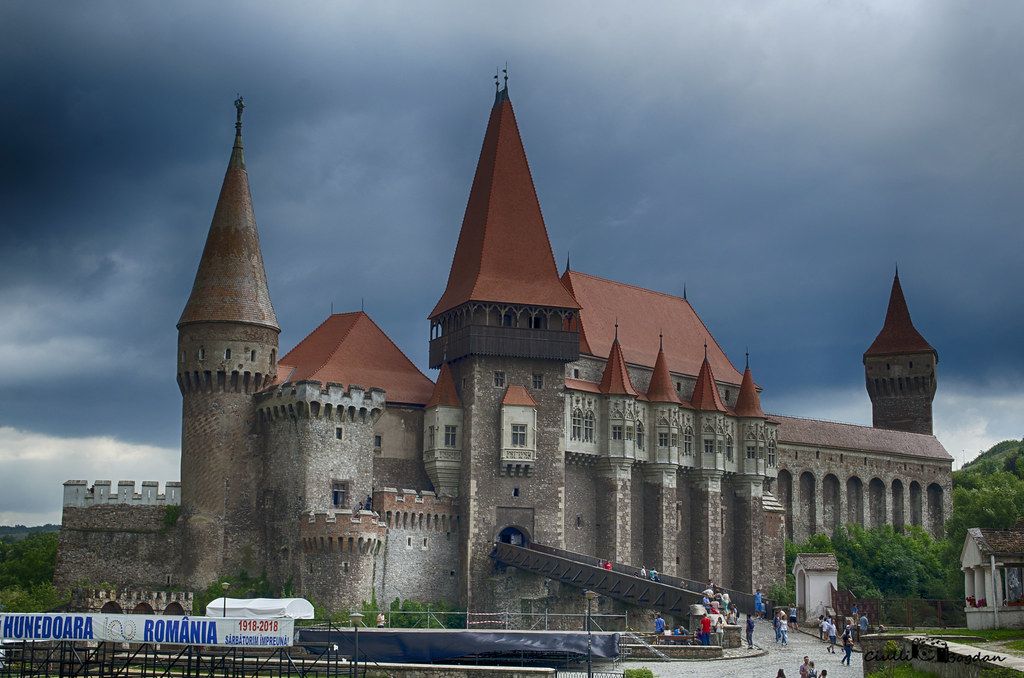
For instance, the addition of a new huge Palace and the construction of two towers, the Artillery Tower and the White Tower. Due to its history and long life span, this remarkable piece of architecture stays shrouded in mystery and legend to this day. Corvin/Hunedoara castle deserves to be one of the best places to visit in Romania due to its sheer beauty and intriguing history. Your trip to Romania is never complete without visiting this remarkable castle.
The Bucegi Mountains
Bucegi Mountains is another great place in Romania that is located in the center region of Transylvania, just south of Brasov. They are the home of two of the most famous landmarks in the country, the Babele and the Sphinx structure. The origins of these rocky formations are still subject to controversy, especially since no scientific evidence can fully explain the occurrence. The nearby Babele Cabin is undoubtedly the ideal place to crash.
It provides a perfect foundation for viewing those excellent landmarks along with this famous Sphinx without having to hike up the mountain. The Sphinx formation was photographed for the first time during the 1900s, but the picture was taken in the front and not at the side. Consequently, it was not until 1936 that the rocky formation acquired its Sphinx name. The distinct shape shows itself only when viewed from a specific angle.
Brasov
Easily accessed by train via Bucharest, Brasov is the most charming centralized city in Romania. Its medieval charm, narrow cobblestone streets, and relaxed mountain atmosphere make any trip there worthwhile. Most tourists check out the Black Church and the city center, and they think it is enough to visit. However, ask any local, and they will tell you not to miss the fantastic panoramic views from above on Tampa Mountain.
A cable railway gondola will take you to the peak (955 meters in height). Just follow the signs towards the Belvedere point for a clear view of the entire city. You can also go on foot but ask rangers beforehand about bear presence, as they roam the area. There is a Brasov sign at the summit of this inspired by the famous Hollywood one.
Rasnov Fortress
Considered one of the best-conserved rustic citadels in Transylvania and one of the best places to visit in Romania, Rasnov fortress is located just 15 kilometers away from Brasov. Overseeing the small town of the same name, the citadel has a very exciting history. The locals built it in the 13th century in case of foreign raids and would use it as shelter. Today, its charming uneven stalls and the beautiful surrounding landscape make it a unique place to explore.
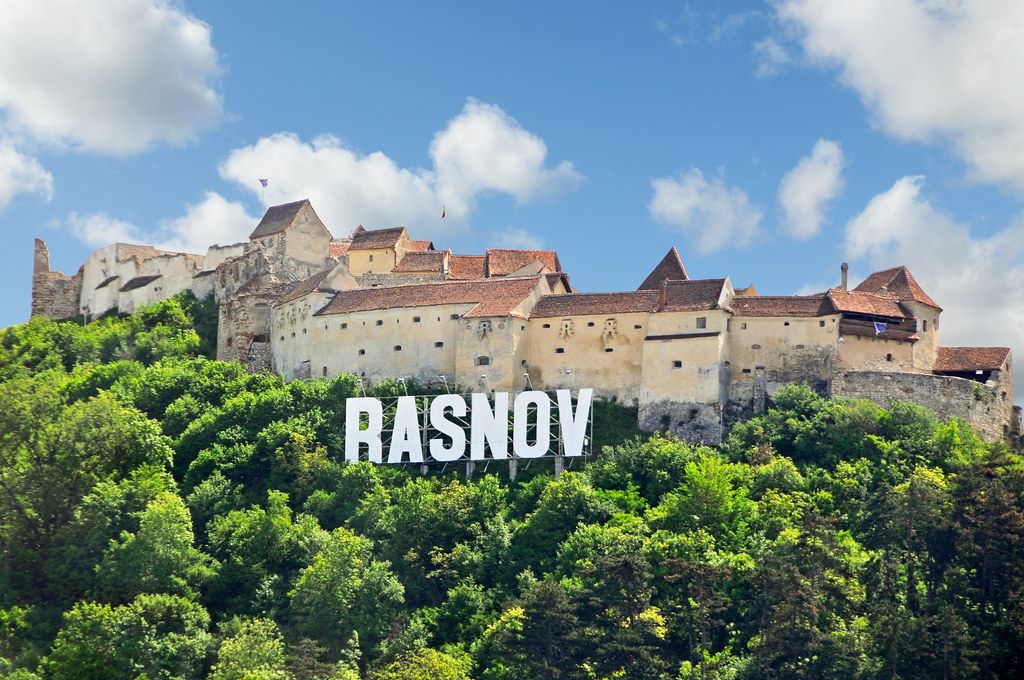
Its complex structure features several towers and two lovely courtyards. A feudal art museum inside the citadel offers insights into the day-to-day life of locals through artifacts with everything from household tools to weapons on display. Once inside the fortress, be sure to peek out of all its hidden small windows for stunning views. For bigger and better views, look through a telescope at the entire valley below the citadel from the observation point. The entrance fee is less than $5 USD.
Sighisoara
Accessible via direct train routes from Bucharest, Sibiu, Vienna, or Budapest, Sighisoara is a medieval masterpiece that you should not miss. Built by German artisans and merchants during the 12th century over a former Roman settlement, this lovely town is full of history and intrigue. In July, the local populace doubles during the Sighisoara Medieval Festival.
If you don’t mind the crowds, it is worth planning to enjoy outdoor plays, concerts, dance competitions, and art installations. You can walk up the Covered Stairs to the Hill Church to find a stunning panorama over the city. The 14th-century Clock Tower, also a real emblem of this 700-year-old town, provides a great view of the older town center.
Viscri Fortified Church
Viscri is one of the six fortified churches in Romania introduced to UNESCO world heritage site. The place became famous with its link with King Charles, who began purchasing properties in Viscri during the ’90s. Viscri is unique in that it reflects that humans can be in harmony with nature. The lush landscape will truly impress you.
The richness of the greens provides an avenue for you to lose yourself along the main street and on through the trees and hills. To get into the church, you need to walk on a path to the peak of a hill. After a couple of steps on your way, you will see tall walls with towers’ roofs covered in red tiles. The village is a throwback to a time when people still used horses as a mode of transport and wore chainmail armor when they went to battle.
Rupea Citadel
Construction of the Rupea fortress began in 1324, during the uprising of the Saxons from the Hungarian king Charles Robert of Anjou. Afterwards, two courtyards and three defensive towers were added to the first structure. Throughout the years, the Rupea served as a refuge for the people in the surrounding villages from repeated sieges of the Turks and Tartars. At the turn of the century, the Saxons eventually surrendered the castle to the Habsburg armies without fighting.
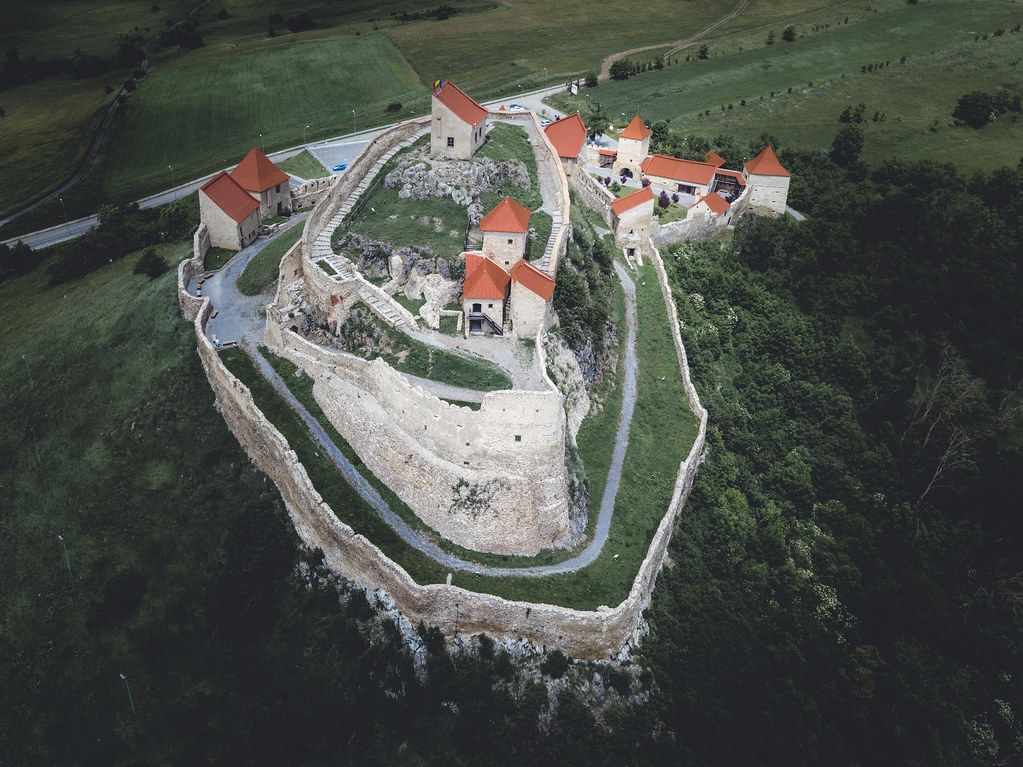
The town’s inhabitants finally abandoned in 1643, as fires raved it to rubbles. The fortress has an ascending spiral, and its fortification system consists of three chambers, the Upper Citadel (built before German occupation), the Middle Fortress (built in the XVth century) and the Lower Citadel (dating from the eighteenth century). To reach the gates of the fortress, you must climb a narrow road, but well worth the effort for the amazing views.
The Transfagarasan Road
This is the road that cuts through the highest mountains in Romania, which consists of 90 kilometres of twists and turns as it winds its way to the peak. It starts near the city of Pitesti and links the historic Romanian regions of Transylvania to Wallachia. The dictator Ceausescu, who wanted military access across the Fagaras Mountains in case of Soviet invasions, built the road with 6 million kilograms of dynamite between 1970 and 1974. Forty soldiers lost their lives during its construction.
Whether you choose to drive by car, bicycle, or motorbike, the dramatic surrounding landscapes are sure to impress. When you get to the end of the road (it climbs up to 2034 meters in altitude), your reward, Balea Lake, awaits. Be sure to plan your visit in the summer, as there are road closures from late October to June due to the inclement weather.
Alba Iulia
The city of Alba Iulia, in Alba County, is one of the most important urban centers of Romania and a place of huge historical significance. It is associated with the Great Union of 1918 with the coronation of the kings Ferdinand I and Mary – the first monarchs of Greater Romania. Its ancient medieval center, the Alba Carolina fortress, reveals within its walls are old attractions laden with a history that includes Saint Michael’s Cathedral. In the XVIII century, the Marquis de Vauban designed Alba Carolina’s innovative system of barricades and defenses. Little did he know that his designs would earn him international recognition throughout the ages. Today, there are many fortresses built using this system.
Sibiu
Sibiu is located in the topographical center of Romania on the northern side of the Carpathians. It was called Hermannstadt by the Saxons and Nagyszebent by the Hungarians in the past, but nowadays this city is known as Sibiu. It is one of Romania’s most beautiful cities and it mixes the best of medieval Europe with a modern spin that has convinced some of the biggest names in the hotel business to open shop here.
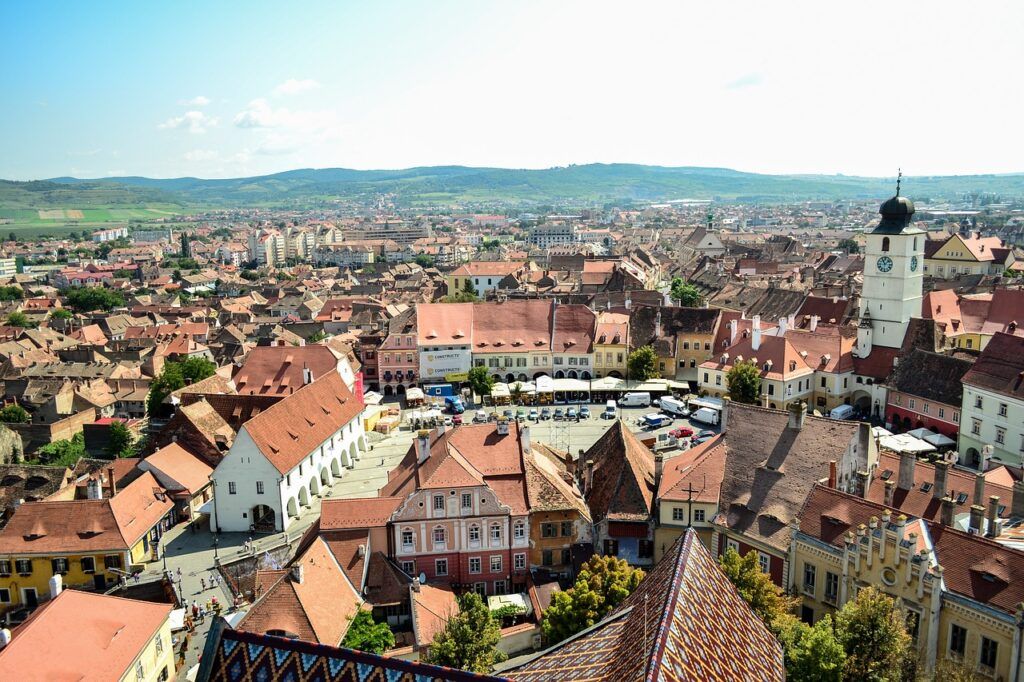
With a population of just over 170,000, Sibiu is one of the smaller cities in Transylvania. However, it has an international airport, which is unusual in Romania for such a small city and newly renovated Old Town. Sibiu is now a genuine rival to the better-known Brasov as Transylvania’s tourist destination. The European Union named the city the European Capital of Culture in 2007, and it earned a spot here as one of the best places to visit in Romania.
Faget-Ghimes
Formerly, the Romanian army, between 13th and 20th November 1918, occupied a Hungarian before World War 1. Shortly afterwards, the Union of Transylvania with Romania was finally proclaimed, and the village, with the rest of Transylvania, formally passed from Hungarian to Romanian control. In 1940, the Second Vienna Award granted Northern Transylvania to Hungary, and they held it until 1944. With the Soviet occupation near the end of World War 2, the Soviets gave it back to Romania.
Up to 1918, it was a border village between Hungary and Romania. Faget-Ghimes had a significant and big railway station designed by Hungarian architect Ferenc Pfaff. The main building of the station was 102 meters long and 13 meters wide, comparable in size and complexity with the railroad stations of the time. The village was part of the Székely Land region of the historical Transylvania province, first mentioned in 1600 as Gijmes. The area of the commune belonged to Csíkszék until the administrative reform of Transylvania in 1876, when it fell within the Csík County of the Kingdom of Hungary.
Neamt Citadel
Neamt Citadel is possibly one of the most spectacular citadels in Romania. It is found in the northeastern part of the country near Targu Neamt. The Citadel boasts massive walls, while the center of the fort includes a large inner courtyard surrounded by different buildings, each with its own distinctive function. The west side included the storage area, kitchen, prison, and money area, while the west side got the armory, a judgment room, and a departure hallway.
Bran Castle
Bran Castle is by far the most popular landmark in Romania. They marketed the Dracula legend well, and now Bran attracts millions of visitors a year, making it one of the best places to visit in Romania in many traveler’s eyes. The castle is is usually assumed to be Dracula’s Castle due to the legend’s fame outside of Romania from Bram Stoker’s book Dracula. The name Dracula actually comes from Vlad the Impaler’s father. In 1438–1442, the castle served as a defense against the Ottoman Empire and later became a customs post on the mountain pass between Transylvania and Wallachia.
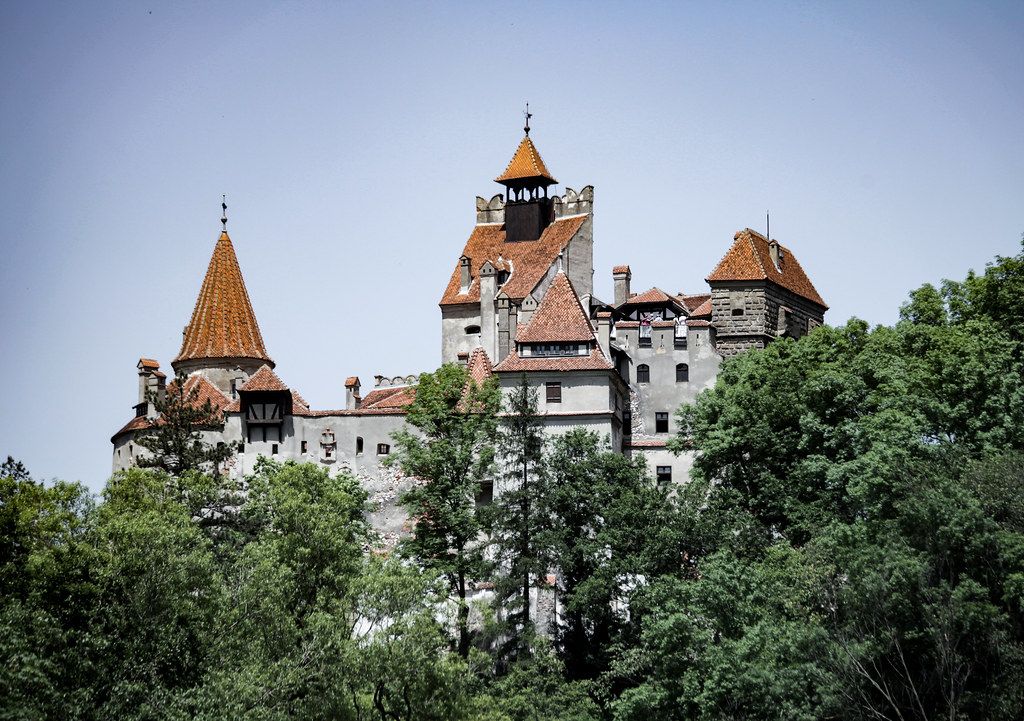
Furthermore, the castle was temporarily held by Mircea the Elder of Wallachia (r. 1386–1395, 1397–1418), during whose period the customs point was established. The first documented mention of Bran Castle was an action by Louis I of Hungary on 19 November 1377. It provided the Saxons of Kronstadt (Brașov) the liberty to build the stone castle at their own cost and labor force. The settlement of Bran began to develop thereafter. If you want to add a little spice to this venue, go check it out during Halloween and get a few scares in.
The Transalpina
Transalpina is a road winding through the Parang Mountains in Romania. It is actually one of the most well-known roads in the country. You should plan your trip there accordingly, as Transalpina receives heavy snowfall and is, therefore, closed off during the winter. There are various hypotheses about the origins of the road, each being quite contentious in its very own method. Back in 1934, King Carol II wanted a modern pathway that would guarantee easy access to the hills because of his armed forces. The pathway, completed in 1939, is nicknamed The King’s Road.
Turda Saltworks
The first record that speaks about the existence of a salt mine in Turda dates from 1 May 1271. Records preserved from the thirteenth and fourteenth centuries mention that salt was found in Băile Sărate micro-depression and on the south-eastern slope of the Valea Sărată. The inhabitants extracted salt here throughout the antiquities. The mine continuously produced table salt from the Middle Ages (first mentioned in 1075) to the early 20th century (1932). However, the Salina Turda Saltworks ultimately went out of business mainly because of obsolete technologies, decreased salt yield, and because of growing competition. Today, this area flaunts its own amphitheater, treatment rooms and a great underground Salt Lake rumored to have healing properties.
The Danube Delta
Located in Tulcea County, the Danube Delta is one of the biggest and most well-preserved deltas in Europe. The region is hugely popular since it provides endless chances for exploration and sightseeing. If you decide to make a stop at the Danube Delta, I recommend that you do it in the spring because fleas tend to be a nuisance in the summer. If fishing is your thing, then you want to schedule a trip through the fall to enjoy larger grabs. Housing is plenty, but choose Airbnb, which is more economical and offers an actual experience.
Timisoara
Nearby archaeological finds show settlements of Neolithic and Roman roots. First documented in 1212 since the Roman castrum Temesiensis, Timişoara in the 14th century became a fortress over marshland. The Tatars sacked the city in the 13th century. However, its citadel was eventually rebuilt and, for a couple of years, was the residence of Charles I of Hungary (1309–42). Nowadays, this beautiful city is a cultural center. There are several higher education bodies, including the University of Timisoara (founded 1948). Timisoara has a state theatre, a state opera and ballet, a philharmonic orchestra, and a library.
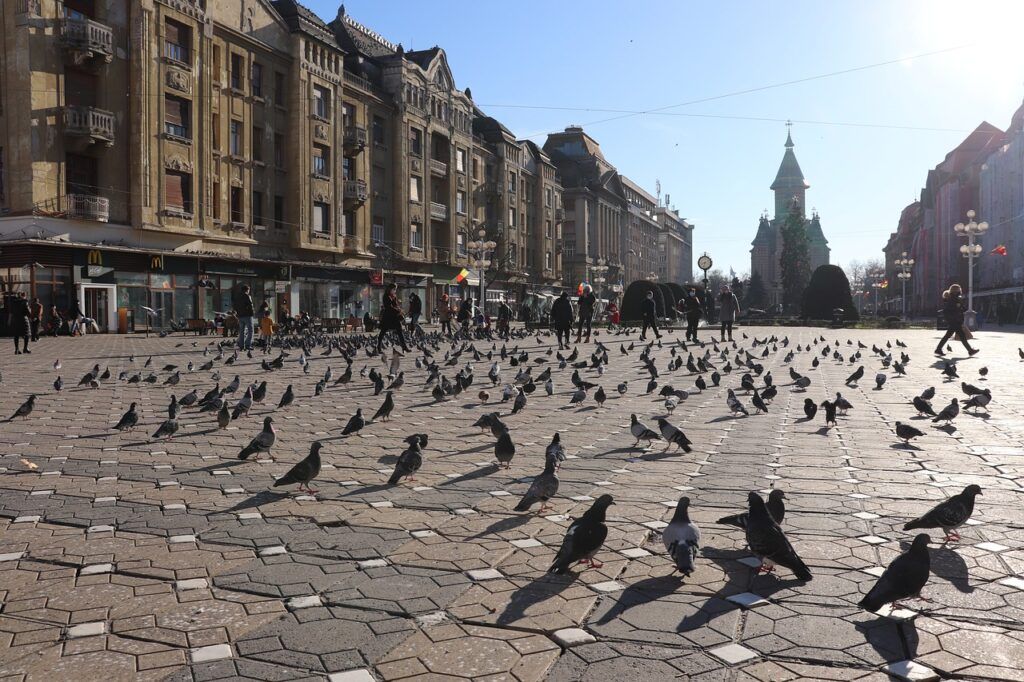
There are parks across the navigable Bega Canal, which runs through the center of the city. Principal buildings include the monumental Roman Catholic cathedral (1736–73), the Serbian cathedral (1748, restored 1791), and the regional museum, housed in a restored 14th-century palace. From 1552, the Turks held the town until the Austrians took it in 1716. Following the Treaty of Passarowitz in 1718, the city and the area, known as the Banat of Temesvár, were governed from Vienna and colonized by non-Magyars, mostly Swabian Germans. The city withstood a siege by Hungarian revolutionaries, lasting 107 days, in 1848. Occupied by Serbia in 1919 and eventually allotted by the Treaty of Trianon (1920) to Romania.
During the communist era, an anti-government demonstration erupted in Timisoara on December 15–17, 1989. This sparked the revolution that toppled the Romanian communist leader Nicolae Ceaușescu from power a few days afterward. Ceaușescu’s use of deadly force to suppress the demonstrations in Timisoara eventually spurred the army to defect to the side of the uprising. Timisoara definitely is one of the best places to visit in Romania.
Peles Castle, Sinaia
On the route to Brasov from Romania’s capital, Bucharest, you can visit the picturesque Peles Castle, which was built between 1873 and 1914. This Neo-Renaissance landmark was commissioned by King Carol I and briefly served as the headquarters of the Romanian monarchy. When the Communist regime took over, the castle and its surrounding buildings became a state park area. Today, the museum has the title of one of the most elegant castles in Europe. Ruling over this part of the Carpathians, the Peles Castle consists of no less than 170 rooms and shelters.
It houses valuable painting collections, sculptures, expensive furniture elements, and an overall glamorous interior design. The entrance fee varies according to the type of tour. Admission (without a tour) starts at 20 RON. It’s far more rewarding to visit the Peles Castle during a hike. Sinaia is a launch pad for many mountain trails. There is no better way of relaxing after a hike than going on a tour of the palace. Wild bears roam in this area, so make sure you talk to a ranger before setting off on a hike.
Balea Lake Ice Resort
The Balea Lake lies in the heart of the Fagaras Mountains of Romania and is decidedly one of the most renowned destinations in the country. The Ice Hotel is accessible entirely during the wintertime for winter sports, and it features a different theme every year. Locally sourced materials, such as giant ice cubes obtained from the nearby Balea Lake, shape the hotel annually. Spending some time in this superb hotel is an awesome experience.
Guests start by ascending to the hotel site by cable car while still enjoying amazing mountain panoramas before retiring to their own arctic room. Nightly rates start at about $123 for double occupancy while a more private igloo-type room would set you back $185 per night.
Cluj-Napoca
Informally considered the capital of Transylvania, a magnificent city of Romania, Cluj-Napoca lies in the Northwestern region of Romania. With a dynamic social landscape, the city is the second largest in the country. Cluj is an excellent place to base yourself whether you are working or wanting a happening nightlife.
Retezat National Park
A superb destination for people who enjoy hiking or people who just want to unwind, Retezat National Park has more than 80 beautiful lakes. Hundreds of rare species of flora and fauna and accessible hiking trails. You need at least four days to get the most out of your visit here. Carry your own tent, warm clothes, and sleeping bags. Set up camp near Bucura Lake, the largest glacial lake in Romania. From this spot, there are various day trips you can take without having to carry a heavy load. Rest assured, no one would steal your tent.
The Retezat Mountains in Romania have two qualities that make them tempting to hikers all around the world. They are both accessible and spectacular. You can reach the mountains by train and minibus via Timisoara (served by the international airport Traian Vuia). If you are not certain you are heading in the right direction, just ask the driver or fellow travelers. There are many people traveling to Retezat from Timisoara in the summer, and nearly all of them speak English. The entrance fee is only $2.
Check out more articles about Romania:

